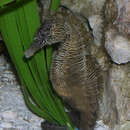fr
noms dans le fil d’Ariane


Seahorses are also known for their prehensile tails. In the first two weeks or month of life, a young seahorse is extremely agile and may bend the tail backward in a reverse crescent, but the tail is prehensile only in a forward direction. Adult seahorses seldom carry the tail in a straight position, usually having it coiled forward. (Marshall, 1966, pg. 37)
Perception Channels: tactile ; chemical
Seahorse populations in the wild could vanish if they continue to be exploited for traditional Chinese medicines, the aquarium trade, and as tourist curios. Countless seahorses are also lost every year with the destruction of their coral reef, sea grass, and mangrove habitats. More than 20 million seahorses are collected each year, causing some seahorse populations to crash by 50% over the last five years. These and other results from the first major study of the international trade in seahorses released by TRAFFIC, a global wildlife trade monitoring group, suggest that Hippocampus erectus should be considered threatened. (Coral Forest)
IUCN Red List of Threatened Species: vulnerable
Worldwide there is a huge demand for seahorses for traditional Chinese medicine and the aquarium trade. Seahorses are considered a powerful aphrodisiac and are used to treat an array of ailments including asthma, impotence, infertility, throat infections and lethargy. Seahorses are also extremely popular in the aquarium trade and as tourist curios. (Coral Forest)
The seahorse, like all of the species of the family Syngnathidae, require living food. They are unable to move rapidly enough to chase their prey. Instead, the seahorse uses its elongated snout to suck in small crustaceans. Seahorses have an almost pinpoint accuracy within the 1 inch range. Young Hippocampus erectus may feed for as long as ten hours of each day and consume up to 3600 baby brine shrimp during that time. (Herald, 1961, pg. 147; Moyle and Cech,1982, pg. 294)
Hippocampus erectus is found from Cape Cod (and rarely Nova Scotia), Canada to Argentina and into the Gulf of Mexico. (Aquatic Bookshop)
Biogeographic Regions: atlantic ocean (Native )
Hippocampus erectus is strictly marine in habitat, and is found in seaweed and on coral reefs at depths of .5 - 30 m. (Aquatic Bookshop)
Aquatic Biomes: reef ; coastal
Average lifespan
Status: captivity: 4.7 years.
The seahorse, including several species in the genus Hippocampus, is one of the most unusual in appearance of all fishes. Its upright position, horse-like head set at right angles to the body, and jointed armor make it resemble a knight in a chess set. The seahorse has a prehensile tail, which it uses to hold onto seaweed and coral. The scales have been replaced by rings of about 50 rectangular bony plates, encasing the body in a semi-rigid skeleton. The eyes can swivel independently or converge to achieve binocular vision. The most distinguishing feature between the male and the female seahorse is the kangaroo-like pouch that the male has on its ventral side, used for reproduction. (Grolier, 1996)
Hippocampus erectus is a large species of seahorse, growing up to 5 inches long. H. erectus is easily separated from other species of seahorse by a pattern of dark lines on a lighter background in its coloring. H. erectus also has 18 to 21 dorsal-fin rays. (Bohlke and Chaplin, 1968, pg. 183)
Other Physical Features: bilateral symmetry
Seahorses reproduce sexually through internal fertilization and spawn during every season. With Hippocampus erectus, as with all seahorses, it is the male that cares for the young. Male seahorses have an incubation pocket, similar to the pouch of a marsupial mammal, on the lower side of the tail, with an opening that can be closed off. During courtship, female H. erectus spray between 250 and 650 eggs into the male brood pocket, depending on the size of the individual. Development in the brood pocket lasts between 20 and 21 days. After hatching, the free embryos are carried in the pouch until they are capable of fairly active swimming. When it is time for the incubated young to be born, the prospective father holds fast to a plant stem or some other object by his prehensile tail. He bends rapidly, sharply, backward and forward; the pouch opens and a baby seahorse pops out. With brief intervals between births, the jerking motions are repeated until the pouch is emptied. Each infant seahorse emerges head first and is a swimming, independent miniature of the adult. Newborn H. erectus are about 5/8 of an inch in length, and within 8-10 months reach their maximum size of 5 inches in length. (Moyle and Cech, 1982, pg. 120; Schultz, 1948, pg. 114; National University of Singapore)
One of the complications of seahorse birth is that some of the unhatched seahorses may die within the pouch before birth, and this soon results in the formation of gas. The male then virtually becomes a balloon and is quickly buoyed to the surface, where he is immediately be picked off by some hungry fish. (Herald, 1961, pg. 148)
Average age at sexual or reproductive maturity (male)
Sex: male: 273 days.
Average age at sexual or reproductive maturity (female)
Sex: female: 273 days.